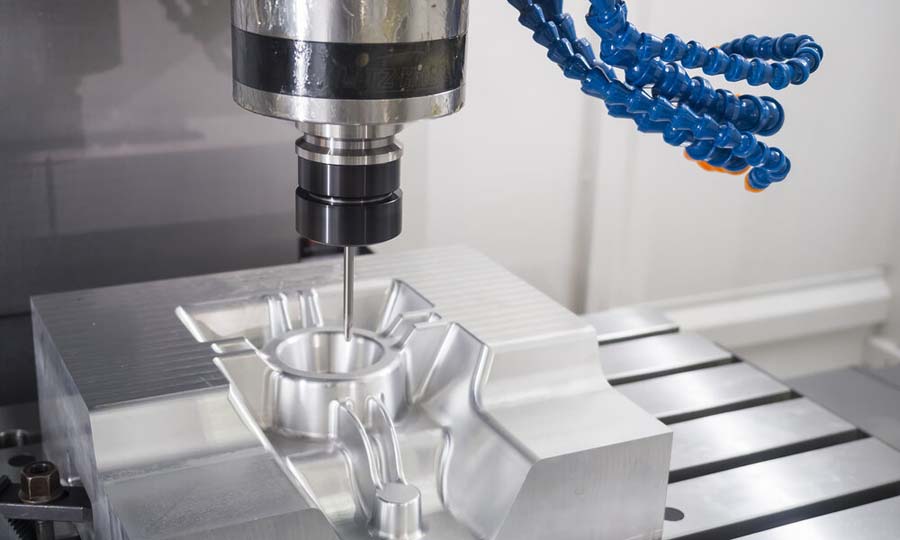In product development, one of the most fundamental decisions a designer must make is how a part will be manufactured. A CAD model is just a digital file; turning it into a physical object requires a manufacturing process. For a vast majority of plastic and metal components, this choice boils down to two industry giants: CNC Machining and Injection Molding.
While they can sometimes produce similar-looking parts, the processes, performance characteristics, and costs differ significantly. Understanding these distinctions is essential when determining which manufacturing method best fits your design requirements, production volume, and budget.
What are Machined Parts?
Machined parts are created through subtractive manufacturing — material is precisely removed from a solid block (metal or plastic) using CNC machines, lathes, mills, or drills. The process allows for tight tolerances, smooth surface finishes, and complex geometries that can be refined to meet strict design standards.
Common machining processes include:
- CNC milling and turning
- Drilling, grinding, and tapping
- Electrical discharge machining (EDM)
- Surface and cylindrical grinding
Machined parts are typically used in low to medium production volumes or when dimensional accuracy and material strength are top priorities.
What are Molded Parts?
Molded parts, by contrast, are produced through formative manufacturing, where material (commonly plastic or metal powder) is heated and injected into a mold cavity to form the desired shape. Once cooled or solidified, the part is ejected and may undergo minimal post-processing.
Common molding methods include:
- Plastic injection molding
- Compression molding
- Die casting (for metals)
- Silicone or rubber molding
Molding is ideal for mass production, as once the mold is made, thousands of identical parts can be created quickly and consistently.
What Are The Differences Between Them?
Material Differences
Machined Parts
Machining supports a wide range of materials, including:
Metals: Aluminum, stainless steel, brass, titanium, copper, carbon steel
Plastics: PEEK, Delrin, Nylon, PTFE, and acrylic
This flexibility allows manufacturers to select materials based on strength, temperature resistance, or chemical compatibility. Machined parts often maintain the original material’s full mechanical properties, since they are not subjected to melting or curing processes.
Molded Parts
Molding primarily uses thermoplastics and thermosetting polymers, such as ABS, polypropylene (PP), polycarbonate (PC), and nylon. In metal injection molding (MIM) or die casting, materials like zinc, aluminum, and magnesium alloys are common.
However, molded materials may experience property variations due to temperature, pressure, and cooling rates during the molding process — potentially affecting density, strength, and surface finish.

Dimensional Accuracy and Surface Quality
Machined Parts
One of the biggest advantages of CNC machining is high precision. Machined parts can achieve tolerances as tight as ±0.005 mm (±0.0002 in), making them suitable for precision assemblies such as aerospace engine components or surgical tools.
Additionally, surface finishes can reach Ra 0.4 µm or better, and finishing operations like polishing, anodizing, or coating further enhance appearance and durability.
Molded Parts
Molded parts offer excellent repeatability once the mold is properly made, but dimensional precision is typically lower than CNC machining due to potential shrinkage and mold wear.
Surface finish depends on the mold quality — high-gloss or textured finishes can be replicated, but achieving micro-level smoothness or exact tolerance often requires secondary machining or polishing.
Production Speed and Cost
Machining
Machining is best suited for low to medium production runs. Setup time is relatively short, making it economical for prototypes or customized parts. However, per-part cost increases with production volume due to tool wear and machining time.
Advantages:
- No need for expensive molds
- Quick design modifications
- Ideal for prototyping or limited production
Limitations:
- Slower production rate
- Higher material waste due to cutting
- Costly for large-scale manufacturing
Molding
Molding, on the other hand, involves a high initial cost to design and produce the mold, but once completed, each additional part becomes inexpensive and fast to produce. It is highly efficient for mass production.
Advantages:
- High production speed
- Excellent cost efficiency for large volumes
- Consistent part quality
Limitations:
- High upfront tooling cost
- Longer lead time for mold fabrication
- Design changes require new molds
Design Flexibility and Complexity
Machining offers superior design flexibility, especially for low-volume custom parts. Engineers can easily modify CAD models and adjust machining programs without additional tooling investment. Complex internal features, deep holes, and undercuts can be achieved with multi-axis CNC systems.
Molding, however, excels in shape replication and efficiency. It allows for complex geometries like ribs, threads, and logos in one forming cycle. Yet, certain intricate internal geometries may require additional inserts or slides, adding cost and complexity.
Mechanical Strength and Performance
Because machined parts are made from solid billets, they retain uniform material properties with no internal voids or weak spots. This makes them ideal for structural or high-load applications.
Molded parts, however, may exhibit anisotropic strength, meaning their mechanical performance varies by direction due to material flow patterns during molding. While additives or fillers can enhance strength, molded components are generally not as durable as machined metal parts.
Post-Processing and Finishing
Both manufacturing methods often require some degree of finishing:
Machined Parts:
Deburring, polishing, anodizing, plating, and heat treatment to improve appearance and performance.
Molded Parts:
Trimming flash, painting, or surface texturing to achieve the desired look.
However, machining typically achieves higher finishes directly from the machine, while molding relies more on surface replication and post-treatment.
How to Choose: A Simple Guide
Here is a simple breakdown of when to choose each process.
Choose CNC Machining When:
- You are in the prototyping stage. You need 1-50 parts quickly to test a design.
- Your design is not finalized. You anticipate making changes and need the flexibility to iterate.
- You have a low-volume production run. Your product is a custom or niche item with a total life volume of a few hundred parts.
- You need parts made from metal. Machining is the default and most cost-effective method for producing metal parts in low-to-mid volumes.
- You require extremely tight tolerances that molding cannot achieve.
Choose Injection Molding When:
- You are in the mass production stage. You need 10,000 or more identical parts.
- Your design is 100% finalized and validated. You are ready to “lock in” the design.
- The lowest possible per-part cost is the primary goal.
- You are making plastic parts. This is the definitive process for mass-producing complex plastic components.
- You need features that are easy to mold but difficult to machine, such as living hinges or integrated snap-fit enclosures.
Conclusion
Both machined and molded parts play essential roles in modern manufacturing. Machining ensures superior accuracy, flexibility, and strength, while molding delivers speed, cost efficiency, and repeatability.
In many cases, companies even combine both processes — machining molds for injection molding or performing post-machining on molded parts for tighter tolerances.
Ultimately, understanding the strengths and limitations of each method empowers engineers to make informed choices that balance performance, cost, and scalability — ensuring every product meets its intended purpose with precision and efficiency.

